
Types of hair loss and its causes
Mar 10, 2020
Introduction
There are three stages of hair growth, namely anagen, catagen, and telogen phases. At any given time, any strands of our hair could be at any of these phases.
Anagen Phase (First phase)
- The growing stage of the hair
- The cells in the hair bulb divide rapidly creating new hair growth
Catagen Phase (Second phase)
- The transition phase
- Hair stops growing and slowly detaches itself from the blood supply
Telogen Phase (Third phase)
- Resting phase
- Hair is released and fall out
It is usual for one to lose up to 100 strands of hair each day. If you are losing more, be aware and figure out what type of hair loss you are facing, so that you know how to cope with it.
“Alopecia” is the medical term referring to hair loss. Hair loss is caused by numerous reasons, and each may lead to different patterns of hair loss. Knowing the types of hair loss and its causes help people to treat their hair loss successfully.
1. Androgenic Alopecia (AGA)

What: This is also known as patterned hair loss – the most common type of alopecia in both men and women. In men, the frontal hairline recedes with bitemporal hair loss that merges with vertex thinning. On the other hand, the anterior hairline remains preserved in women, and thinning tends to occur mainly at the crown (the top of head)1.
Why: It is the effect of an androgen known as dihydrotestosterone (DHT) on hair follicles of the scalp, which gradually shrink the hair follicles and eventually stop producing hair1.
2. Alopecia Areata
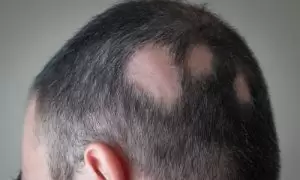
What: Also known as spot baldness, which is a condition that causes hair to fall out in round patches. Men and women are equally affected1.
Why: Alopecia Areata is an autoimmune disease – the attack of the immune system on hair follicles. Hair loss may progress to Alopecia Totalis (complete balding at the scalp) or Alopecia Universalis (loss of all hair on the body) 2.
3. Telogen Effluvium
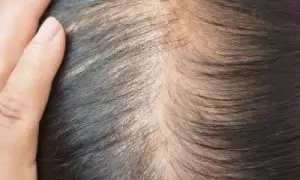
What: This is a form of non-scarring alopecia characterized by diffuse hair shedding, often with an acute onset. If hair loss persists more than six months, acute Telogen Effluvium may progress into chronic state1.
Why: Acute form can be triggered by diverse events, for instance: childbirth, febrile illness, major surgery, and rapid weight loss2. These stressful events cause hair roots to be pushed prematurely into the resting state3.
4. Anagen Effluvium
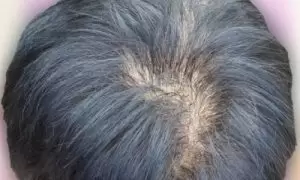
What: Anagen Effluvium is diffuse hair loss characterized by hair breakage during the anagen phase (the growing phase of hair) 1.
Why: A rapid hair loss with onset within 1 to 4 weeks upon exposure to medical treatments such as radiation therapy, cancer chemotherapy, etc. These treatments are believed to shut down the hair follicles production, affecting 80 to 90% of scalp hairs1.
5. Involutional Alopecia
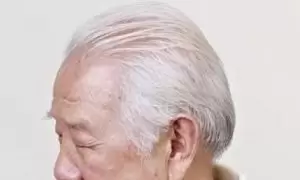
What: This is a natural condition in which the hair gradually get thins with age4. As we age, more hair follicles enter into the resting phase, and the remaining hairs become shorter, finer, and fewer in number5.
Why: This type of hair fall is due to aging process, which shortens the anagen phase (hair growing) while more hairs enter the telogen (resting) and catagen (shedding) phases5.
6. Traction Alopecia
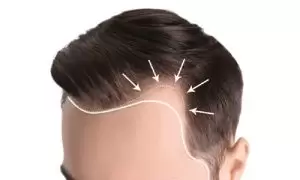
What: It is a type of gradual hair loss frequently found in those people with tight ponytail, pigtails, or braids. The area affected is mainly at the side near the temples and along the hairline1.
Why: This type of hair loss is results from the constant tension or pulling applied to the hair over a long time, causing damage to the hair follicles1.
7. Scarring Alopecia
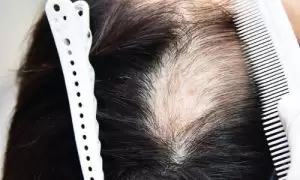
What: Scarring alopecia is also known as Cicatricial Alopecia – a type of hair loss accompanied by scarring. Scarring alopecia is a rare type of hair loss and can lead to permanent baldness. This type of hair loss can begin as one or more permanent bald patches on the scalp. The bald patches appear to be smooth and shiny due to a complete loss of the follicular openings6. It may accompany by other symptoms such as itchiness, redness, presence of pus, and scaly skin on the scalp.
Why: This type of hair loss can be caused by a group of rare disorders that damage the hair follicle and replace it with scar tissue7. If the hair follicles are destroyed, it can lead to permanent baldness.
8. Trichotillomania
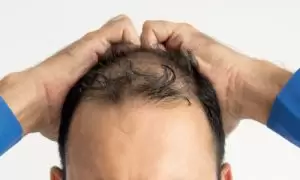
What: It is also known as the hair-pulling disorder, is a mental disorder that drives the individual to pull out their hair compulsively from the scalp, eyebrows, or other areas of the body. The area affected has lesser and shorter hair, with the presence of fractured hair1.
Why: The cause for trichotillomania is unclear; however, it may associates with the abnormalities in brain pathways that link areas involved in emotional regulation, movement, habit formation, and impulse control. Stress, anxiety, or depression may also trigger trichotillomania in certain people8.
9. Scalp Folliculitis
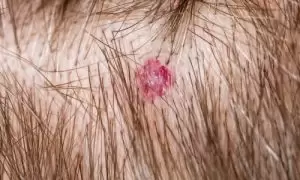
What: Scalp folliculitis is an inflammatory skin condition that affects hair follicles. It is characterized by small, itchy pustules on the scalp. Often, it becomes sore and crusted as they scratch it9.
Why: It is generally caused by an infection of hair follicles with bacteria, yeast, or mites9. Over time, the inflammation can permanently damage the hair follicles and result in hair loss.
10. Lichen Planopilaris
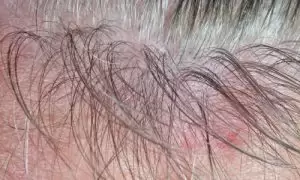
What: Lichen planopilaris is a scarring hair loss that occurs when a relatively common skin disease, known as lichen planus, affects areas of skin with hair. The presence of small patches of alopecia with peripheral follicular hyperkeratosis is the clinical characteristic. The hair at the edge of an affected area is characterized by erythema and collar-like scaling around hair follicles10.
Why: The exact cause is unknown, but it seems to be associated with our immune system. T-lymphocytes, a type of white blood cell, are known to be involved. However, the trigger is not yet known11. The T lymphocytes destroy the follicular stem cells in the bulge area of the hair follicle, leading to irreversible hair loss10.
Take-Home Message
References
- Qi, J., Garza, L.A., 2014. An overview of alopecias. Cold Spring Harb Perspect Med., 1;4(3). pii: a013615
- Pratt, C.H., Jr. L.E.K., Messenger, A.G., Christiano, A.M., and Sundberg, J.P., 2017. Alopecia areata. Nat Rev Dis Primers., 3: 17011
- American Osteopathic College of Dermatology, 2019. Telogen Effluvium Hair Loss.Retrieved from https://www.aocd.org/
page/telogeneffluviumha - Trüeb, R.M., 2006. Pharmacologic interventions in aging hair. Clin Interv Aging, 1(2): 121–129
- HairClub, 2019. Type of Hair Loss. Retrieved from https://www.hairclub.com/why-is-my-hair-falling-out/types-of-hair-loss/
- American Hair Loss Association, 2010. Scarring Alopecia. Retrieved from https://www.americanhairloss.org/
types_of_hair_loss/scarring_alopecia.html - Filbrandt, R., Rufaut, N., Jones, L., and Sinclair, R., 2013. Primary cicatricial alopecia: diagnosis and treatment. CMAJ, 185(18): 1579–1585
- NHS, 2017. Trichotillomania (hair pulling disorder). Retrieved from https://www.nhs.uk/conditions/
trichotillomania/ - DermNet NZ, 2014. Scalp folliculitis. Retrieved from https://dermnetnz.org/topics/scalp-folliculitis/
- Wolff, H., Fischer, T.W., and Blume-Peytavi, U., 2016. The Diagnosis and Treatment of Hair and Scalp Diseases. Dtsch Arztebl Int., 113(21): 377–386
- British Association of Dermatologists, 2019. Lichen Planopilaris. Retrieved from http://www.bad.org.uk/shared/get-file.ashx?id=97&itemtype=document



